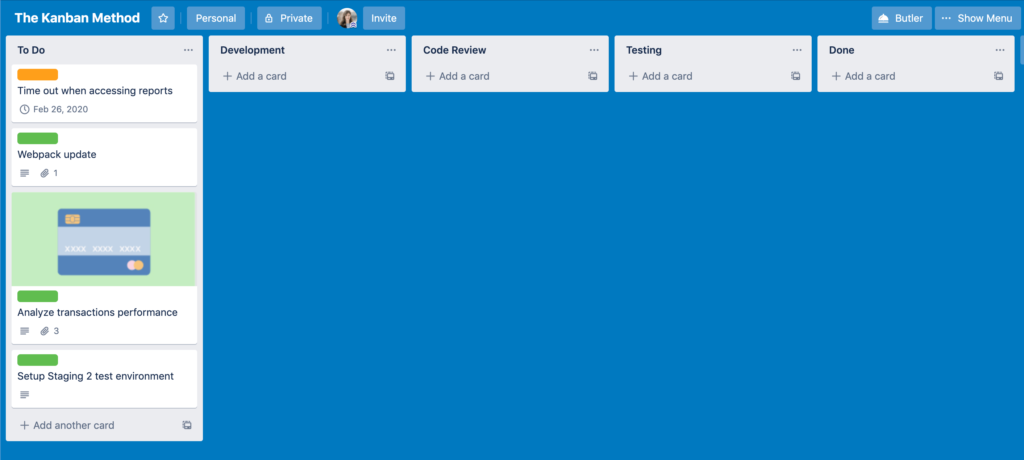The Kanban methodology is a visual work management system that helps teams optimize workflow, improve efficiency, and manage tasks through a pull system.

In this blog post, we will explore the key principles of Kanban, learn how to get started, and discover the benefits it brings to diverse industries.
Key Takeaways
- Kanban is an effective visual work management system for optimizing workflow, augmenting efficiency and managing tasks.
- It involves the use of boards, columns, cards and WIP limits to promote efficient workflow and better delivery performance.
- Adopting a gradual incremental approach with leadership at all levels enables teams to make manageable changes leading to improved efficiency & business outcomes.
- Incorporating kanban boards with goal management accelerates business growth. Learn more
Understanding The Kanban Methodology

Originating from the Toyota Production System (TPS) as a scheduling system for lean manufacturing, Kanban has evolved to become an integral part of Agile project management. The Kanban method encourages continual improvement, feedback loops, efficient resource utilization, visual representation of processes, task assignment to swim lanes, and communication of changes.
Today, software development teams are reaping the benefits of Kanban’s exceptional principles for visualizing their work, delivering products and services in a timely manner, and acquiring customer feedback more frequently and with increased speed. As a result, teams can reach the market more quickly while delivering products and services that meet customer expectations.
Kanban as a Pull System
The primary objective of Kanban systems is to restrict the accumulation of surplus inventory at any stage of the production line. The two-card system employed in electronic Kanban systems comprises of T-kanban transportation cards and P-kanban production cards. The Kanban framework emphasizes the division of work into small tasks, visualization of these tasks, and limiting the amount of items in any given work state. By functioning through a pull system, Kanban enables tasks to be completed on demand and limits superfluous inventory.
The pull system of Kanban also ensures that tasks are only undertaken when there is a need for them. This efficient approach to resource utilization reduces waste and ensures that work items progress through the workflow at a steady pace. In turn, this leads to better overall efficiency and a more streamlined production process.
Key Elements of Kanban

The essential components of Kanban include boards with columns indicating stages of work, cards signifying tasks, and limits on work-in-progress to ensure efficiency. Boards and columns in Kanban methodology visually depict the workflow and progress of tasks, while Kanban cards serve as visual representations of work items, providing a clear indication of the status of the work item as it progresses through the workflow. Work-in-Progress (WIP) limits are essential in Kanban as they foster superior quality and better delivery performance.
Employing these key elements allows teams to manage their workflow more effectively, complete tasks promptly, and enhance their processes. Implementing these core Kanban practices can lead to improved efficiency, reduced waste, and better alignment with business goals.
Boards and Columns
Boards and columns in Kanban are utilized to structure tasks and illustrate the workflow. The columns symbolize distinct stages or activities in the workflow, enabling team members to monitor the advancement of work items as they progress through the various stages. The typical columns on a Kanban board are:
- Backlog
- Inbox or New
- Ready or Prioritized
- In progress
- On hold
- Completed or Done
Boards and columns can be customized to suit the needs of a team by:
- Customizing the columns on the Kanban board
- Customizing the cards on the board
- Renaming the columns
- Creating intricate column structures
- Adding additional fields or information to the cards
Customizing the boards and columns allows for a tailored workflow and visual representation that is suited to the team’s needs and processes.
Kanban Cards
Kanban cards signify individual tasks and their associated information, offering visibility and responsibility. They typically include details such as card assignments, due dates, attachments/links, work type, and status. To effectively utilize Kanban cards in a project management setting, it is recommended to visualize workflow, break tasks into small and achievable units, use columns to represent stages, monitor the flow, and avoid task overload.
As a visual representation of work items, Kanban cards provide a clear and comprehensive view of the progress and status of each task, enabling team members to effectively manage their workload and maintain a smooth flow of work throughout the project. The use of Kanban cards helps teams boost their overall efficiency and guarantee prompt task completion.
Work-in-Progress (WIP) Limits
Work-in-Progress (WIP) limits are set at each stage of the workflow on a Kanban board to motivate team members to complete their current tasks before taking up the next piece of work. This “Stop Starting! And Start Finishing!” mantra encourages team members to prioritize the completion of existing work before taking up the next piece of work. The principle of early delivery in Kanban entails tasks should be expeditiously transferred between columns, rather than remain in an uncertain “in progress” status.
Limiting work in progress helps teams optimize their tasks and remove unnecessary steps from their processes. WIP limits allow the full potential of Kanban to be realized, allowing teams to deliver high-quality work in a more efficient and sustainable manner.
Starting Off With Kanban – Best Practices

Best practices for starting with Kanban include using existing workflows, pursuing incremental change, and encouraging leadership at all levels. Adopting a gradual, incremental approach is recommended when implementing modifications when employing Kanban. Affirmative, Kanban can be implemented within existing workflows and processes.
Fostering leadership at all levels in the implementation of Kanban methodology enables more efficient and sustained change. It provides individuals with the ability to propose changes, voice their opinions, and make decisions quickly, resulting in ongoing improvement across the organization.
Start with Existing Workflow
Beginning with an existing workflow in Kanban involves:
- Taking your current process or method of working
- Representing it on a Kanban board
- Observing the progression of work
- Detecting bottlenecks
- Making enhancements based on the existing process
This is a way to incorporate Kanban into your current workflow without completely altering it.
The steps for transitioning from an existing workflow to Kanban are as follows:
- Visualize your workflow by creating a Kanban board.
- Limit work in progress to increase focus and efficiency.
- Define the workflow steps that align with your team’s objectives.
- Map your existing tasks and projects onto the Kanban board.
- Start moving tasks through the workflow, from ‘To Do’ to ‘In Progress’ to ‘Done’.
- Continuously monitor and refine your workflow based on feedback and data.
Pursue Incremental Change
In reference to Kanban methodology, incremental change involves making small, continuous, and evolutionary changes to enhance processes over time. Kanban encourages teams to pursue incremental changes based on visualized data and feedback, rather than making drastic changes all at once. This approach encourages a mindset of continuous improvement and allows for adjustments without disrupting the current process.
The impacts of incremental change on the Kanban process and on the team include:
- Manageable changes
- A sustainable Kanban system
- Improved efficiency
- A continuous improvement mindset
Incremental change in the Kanban process enables the team to make steady progress, adapt to changing circumstances, and continuously improve their workflow.
Encourage Leadership at All Levels
Leadership in Kanban methodology is the capacity of team members to take the initiative and provide suggestions to optimize the delivery of products and services. Promoting leadership in Kanban methodology promotes collaboration and creativity, and enables changes to originate from any part of the team.
Examples of how to foster leadership in Kanban methodology include:
- Granting team members the freedom to make decisions
- Motivating team members to take initiative and suggest ideas
- Acknowledging and rewarding team members for their efforts
We suggest focusing on increasing the a-sync factor in your organization. Soon, most teams in modern companies will enable asynchronous working if possible and the employees will demand it. The sooner you adapt, the more satisfied your team will be.
Promoting leadership at all levels helps teams cultivate an environment of innovation, collaboration, and ongoing improvement.
Kanban Benefits Across Industries

Kanban is becoming increasingly popular and is being utilized across a wide variety of sectors, ranging from small businesses and start-ups to larger established organizations. In the healthcare sector, Kanban has been known to facilitate:
- Accurate medical supplies management
- Reduced medical inventory costs
- Improved patient care
- Streamlined processes
- Improved patient outcomes
In the IT and software development industry, the influence of Kanban is evident through improved time-to-market, an evolutionary approach to development, a focus on task completion, empowered teams, and its adoption by various industries.
Utilizing Kanban in the education sector, particularly in virtual classes, can be beneficial in tracking class timetables and assessing performances, encouraging creativity and productivity, and promoting development, adaptive thinking, and creativity in classrooms.
Benefits of Adopting Kanban Methodology
Adopting Kanban methodology offers numerous benefits, including:
- Increased visibility
- Faster delivery times
- Improved predictability
- Better alignment with business goals
Kanban improves visibility in a project through its visual management practices, such as the use of Kanban boards, which provide a clear and comprehensive visual representation of the project’s workflow. This allows for better coordination, prioritization of work, and optimization of overall project efficiency.
Kanban improves project management by:
- Defining the value stream
- Optimizing the work process based on measured data
- Actively tracking workflows in real-time
- Utilizing forecasts
- Minimizing variability
- Leveraging data-driven predictions
These benefits make Kanban an attractive option for organizations seeking to enhance their project management capabilities and drive better business outcomes.
Challenges and Limitations of Kanban
Despite its numerous benefits, there are some challenges and limitations associated with Kanban. Some of these include:
- Potential difficulty in dynamic environments, where activities are not consistent
- Regular updates required to maintain effectiveness
- Failing to update the Kanban board can result in a lack of buy-in from the team
- Impedes project visibility and progress tracking
To overcome these challenges, it is important to ensure that teams are adequately trained in Kanban practices and that the methodology is adapted to the specific needs and context of the organization. By addressing these potential issues, teams can effectively leverage the benefits of Kanban and drive better business outcomes.
Tips for Successful Kanban Implementation

Successful Kanban implementation requires clear communication, well-defined policies, and a commitment to continuous improvement. Ensuring the team is provided with proper training, obtaining buy-in from leadership and management teams, utilizing a physical or virtual board to visualize work, and controlling work in progress (WIP) to manage flow are essential for successful implementation of Kanban methodology.
To ensure that process policies are explicit, teams should define and document the rules and regulations that govern their workflow, including establishing WIP limits, stipulating policies for initiating work, and addressing critical requests.
Implementing feedback loops for continuous improvement can be established by periodically assessing and evaluating the team’s progress and performance, incorporating retrospectives, surveys, and other methods of obtaining insights from team members.
How to Get Started? For Individuals and Teams
➡️ Download our free Kanban board template
Tools such as Trello for individuals and Weekdone for teams can simplify the process of beginning with Kanban, offering user-friendly platforms for task visualization and management. Trello offers a visually-oriented and adaptive approach to individual Kanban implementation, while Weekdone is a team productivity tool that facilitates tracking progress based on Objectives and Key Results (OKRs).
Trello for Individuals

Trello is a project management tool that is ideally suited to the Kanban methodology. Its user-friendly visual interface, comprising boards, lists, and cards, enables users to visualize and track work items. To set up a personal Kanban board on Trello, simply create a new board, add columns (or lists) to represent the stages of work, and create cards for each task or project.
Trello’s features, such as customizable cards for task management, visual Kanban boards, and checklists for task organization, make it suitable for individual use and Kanban implementation. The use of Trello allows individuals to manage their tasks more effectively, maintain organization, and enhance their personal workflow.
Weekdone for Teams

Weekdone is a platform designed to facilitate weekly planning, project management, and goal tracking for teams. It enables teams to construct Kanban boards to visualize their workflow, assess progress, and manage tasks. Additionally, Weekdone provides features such as progress tracking, issue identification, and team collaboration – all of which are necessary to successfully implement the Kanban methodology.
The use of Weekdone for team projects enables teams to manage their work more effectively, monitor their progress towards goals, and confirm the alignment of all team members with the overall objectives. This powerful tool can help teams to optimize their workflow, reduce waste, and drive better business outcomes.
Summary
In conclusion, the Kanban methodology offers a powerful and flexible approach to managing work, optimizing workflow, and driving better business outcomes. By understanding the key principles of Kanban, adopting best practices, and leveraging available tools such as Trello and Weekdone, individuals and teams can effectively implement Kanban to enhance efficiency, reduce waste, and foster a culture of continuous improvement.
Whether you are an individual looking to optimize your personal workflow or a team seeking to drive better business outcomes, Kanban provides a proven and adaptable framework for success. Embrace the power of Kanban and unlock your team’s full potential today.
Frequently Asked Questions
What are the 6 practices in Kanban?
Kanban is comprised of six core practices: visualizing work, limiting work-in-progress, managing flow, making process policies explicit, using feedback loops and improving collaboratively. By implementing these principles, organizations can optimize their workflow for a smoother operation.
What is the difference between Agile and Kanban?
Agile is a high-level project management approach emphasizing iterative development, while Kanban boards are visual tools to optimize workflows. Agile promotes continuous iteration of development and testing throughout the life-cycle, while Kanban enables teams to track tasks for optimized flow between different groups.
What is the primary objective of the Kanban system?
The primary objective of the Kanban system is to reduce the accumulation of excess inventory, ensuring a smooth flow through the production line.
What are the key elements of Kanban?
Kanban is a system of managing workflow using boards, cards, and limits on work-in-progress, making it an efficient way to manage tasks.
What are the benefits of adopting Kanban methodology?
Adopting Kanban can provide increased visibility, faster delivery times, improved predictability, and better alignment of business goals, resulting in improved project outcomes.